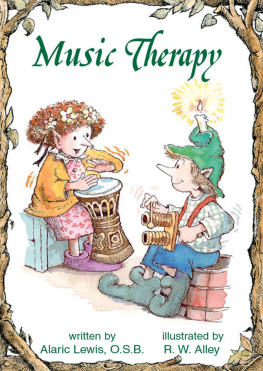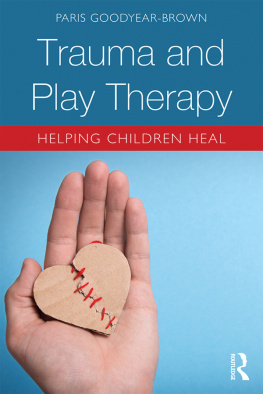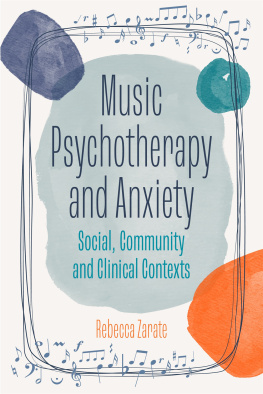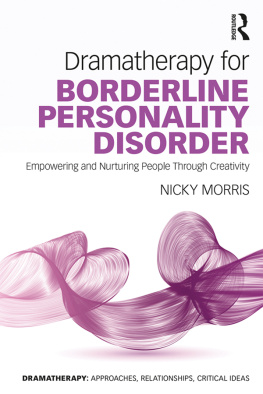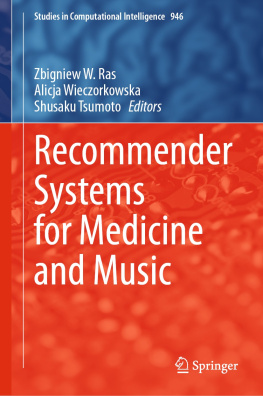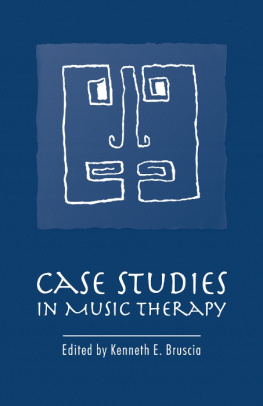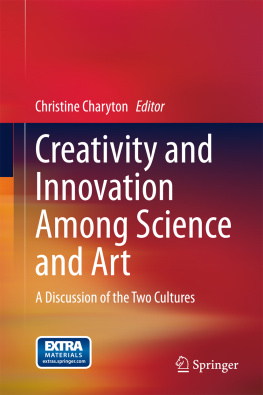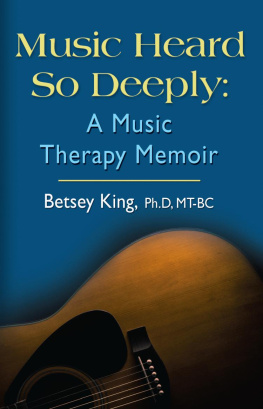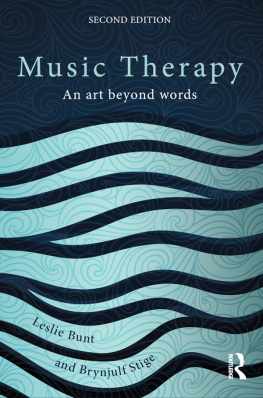
Collaborations
WITHIN AND BETWEEN
Dramatherapy
AND
Music Therapy
Experiences, Challenges and
Opportunities in Clinical
and Training Contexts
EDITED BY AMELIA OLDFIELD AND MANDY CARR
Foreword by Rebecca Applin Warner

Jessica Kingsley Publishers
London and Philadelphia
C ONTENTS
F OREWORD
As a composer for theatre and media, my daily task is to integrate music and drama together, and to interrogate their relationship. This is a subject which occupies my mind in multiple ways: both as composer and as academic. When composing for the stage, I need to find practical solutions for the most appropriate relationship between music and drama for the particular piece I am writing a relationship which differs depending on whether I am writing a musical or a score for a play and depending on whether I am working with recorded music, a separate live band or with actor-musicians. As a researcher and academic in musical theatre, the relationship between music and drama is one that I have questioned, problematized and attempted to theorize upon.
It is within this research context that I first met Amelia Oldfield and Mandy Carr, while working as a Lecturer in Performing Arts at Anglia Ruskin University, Cambridge, and completing my doctorate. Anglia Ruskin University has inspiring provision and a prolific research community in terms of music therapy and dramatherapy, and this book is a natural development and collaboration of that environment. It is made clear within the book that there is little literature regarding the relationship between music therapy and dramatherapy, and that this seems strange considering the connections that have always existed between the two therapeutic disciplines. I was thrilled when I heard that Amelia and Mandy were producing Collaborations Within and Between Dramatherapy and Music Therapy . Both music and drama are compelling forms of interaction, and Amelia Oldfields Humour, Play, Movement and Kazoos: Drama in Music Therapy with Children and Families () reflects on the relationships between music and drama, summarising that both music therapists and dramatherapists are primarily interested in the quality of the communication and dialogue that occurs through this combination of music and drama. Communication is a key feature that is common to all of the discussions in this book.
of Collaborations Within and Between Dramatherapy and Music Therapy , Adam Reynolds and Catherine Davis discuss the transformative potential of musical theatre for both performers and audience alike. During Make a Musical I was particularly struck by one cast member, who did not ordinarily communicate through speaking, but was whole-heartedly singing every song lyric throughout the show. Similarly, during a series of musical theatre projects that I helped Full House Theatre Company to create with the Bedfordshire District Cerebral Palsy Society, individual participants would take on a seemingly transformative burst of energy in relation to puppets that we were using, songs that we were creating together, the playing of a handmade bottle shaker along with the music, or while contributing to the detailed decisions of what the next step of the narrative should be. These experiences resonated in my mind many times while reading Collaborations Within and Between Dramatherapy and Music Therapy. The book demonstrates myriad such responses to music and drama in varying therapeutic contexts: from role play or puppetry within music therapy to the singing of songs and music-making in dramatherapy, such experiences are detailed in the book across a full range of age groups and life experience.
Music and drama are perfect partners. Each retains its own identity and language but both share so much in terms of the responses they can evoke. Both media have the capability of igniting strong emotional resonances, be that a feeling, a memory, or a more abstract sense of familiarity, comfort, or at times unease. Both art forms can have the power to transport, lifting us from the quotidian experience to explore things beyond the everyday, or indeed to contextualize the things that are the stuff of the everyday. Music and drama both have the capacity to be broadly abstract, capturing an impression or a shadow of something; but they also can be very specific, particularly if text is incorporated. As media, they both inhabit a space which can move flexibly between abstraction and specificity, between washes of enigmatic feeling and identifiable meaning. It is perhaps this quality that is found in music and in drama which allows them both to give voice to people, to enable them to express a wide range of sentiments, meanings and impressions; both are simultaneously universal, and highly personal to the individual.
In my specialist field of musical theatre, there has been a long-held school of thought (since the musicals of Rodgers and Hammerstein) that the best musicals integrate song and drama, the idea being that the music should continue to forward the drama, ensuring that it never feels like an adjunct, and that the two performance media merge to become one whole. It is a strong principle and one that I have both aspired to, adhered to, and taught to student writers. However, in The Musical as Drama , Scott McMillin refutes the idea that the relationship between music and drama is smoothed out into a unified whole. Instead he celebrates the difference between the two: When a musical is working well, I feel the crackle of difference. (McMillin 2006, p.2). Collaborations Within and Between Dramatherapy and Music Therapy makes it clear that music therapy and dramatherapy are their own distinct disciplines; there is no suggestion of a new method of combined therapy. Both the within and the between of the books title are important: there are a plethora of types of relationships, co-operations, collaborations and juxtapositions between the two disciplines exemplified in the book. It celebrates the shared space between music therapy and drama therapy and the enhanced results that can be, and have been, produced through recognising the potential in the partnership between the two.
Dr Rebecca Applin Warner
References
McMillin, S. (2006) The Musical as Drama. Princeton: Princeton University Press.
INTRODUCTION
A MELIA O LDFIELD AND M ANDY C ARR
Drama in music
Lee sits at the drum with his mum, Tracey. They are in the music therapy room waiting for the music therapist, Andrew, to come in and he is taking a few minutes to adjust the video-link in another room. Lee is out-of-sorts, grisly and whimpering because his mother wouldnt let him bring a huge toy truck from the waiting area into the music room with him. Andrew walks in and having witnessed the conflict over the truck earlier, immediately sits at the drum and puts his head down on the drum pretending to go to sleep. Lee stops whimpering and looks surprised. Andrew snores loudly and Lee grins, he has played this game before with Andrew. Tracey indicates to Lee that he should play the drum as this might make Andrew wake up. Lee tentatively taps the drum with his hand and Andrew reacts through squirming, but soon resumes his snoring. Lee then hits the drum loudly and Andrew jumps up and responds by playing the drum and singing a song to say Hello to Lee and Tracey. Soon they are all three playing the drum together and Lees anxiety about leaving his truck behind is forgotten.
In this scene, Andrew cleverly pretends to go to sleep as soon as he comes into the room, dramatically accentuating his role through snoring sounds. This role play engages Lee and puts him in a position of control where he is responsible for waking the music therapist up. It also leads to a playful and musical activity where Lee, Tracey and Andrew can play together as equals. Just before the session, Lee was upset because he could not control the situation (i.e. take the truck into the music room) and he did not have an equal role to his mother who would not let him keep it.
Next page

